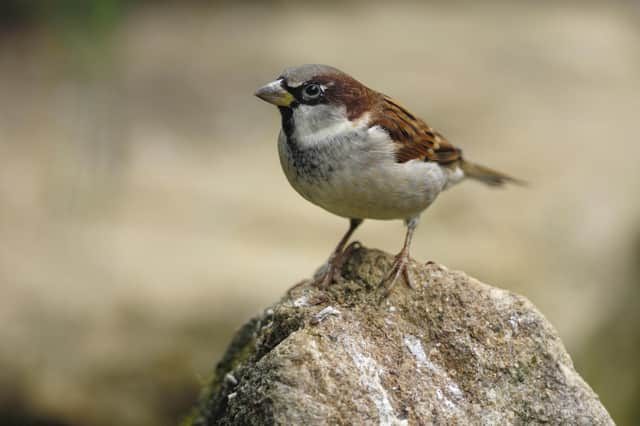The biggest citizen science project checking on the state our birdlife gets underway next weekend


The RSPB Big Garden Birdwatch, which the charity says is the world’s largest garden wildlife survey, runs from Friday, January 28 to Sunday, January 30 and helps take a health check on our bird species.
More than one million people took part in last year’s survey, counting 17 million birds. In West Yorkshire alone more than 29,000 people joined in using packs from the RSPB’s website.
Advertisement
Hide AdAdvertisement
Hide AdBeccy Speight, RSPB chief executive, said they had been “blown away” by the enthusiasm with which people took part in the Birdwatch in 2021.
“By taking part in the Birdwatch, you are helping to build an annual snapshot of how our birdlife is doing across the UK.
“It is only by us understanding how our wildlife is faring that we can protect it.
“We know that for many people, garden birds provide an important connection to the wider natural world and bring enormous joy.
Advertisement
Hide AdAdvertisement
Hide Ad“And over the last two years, there has been a broad and much-needed realisation that nature is an important and necessary part of our lives especially for our mental health and wellbeing.”
Now in its 43rd year, over 150 million birds have been counted during the Big Garden Birdwatch giving the RSPB a huge amount of data on how our wildlife is faring. It has also made it the largest garden wildlife citizen science project.
For four decades, the Big Garden Birdwatch has highlighted the winners and losers in the garden bird world.
Last year, the house sparrow was top of the rankings as the most commonly seen garden bird with 2.6 million sightings over the weekend, the blackbird and starling completing the top three.
Advertisement
Hide AdAdvertisement
Hide AdBut the RSPB said many of the top 20 species have seen declines since the count started 42 years ago and while the house sparrow and starling were the UK’s most sighted birds, figures show that numbers have dropped dramatically since the count began in 1979.
House sparrow numbers are down 58 per cent while starlings are down 83 per cent.
“We know that nature is in crisis,” Beccy said.
“But together, we can take action to solve the problems it is facing.”
The scale of the issues facing our bird population was highlighted in December when the latest Birds of Conservation Concern 5 assessment – more commonly known as the UK Red List for Birds – was published.
Advertisement
Hide AdAdvertisement
Hide AdThe assessment carried out by a coalition of the UK’s leading bird conservation organisations, which includes the RSPB, the British Trust for Ornithology, Wildlife Trusts and National Trust, looks at 245 species regularly occurring in the UK, Channel Islands and Isle of Man and categorises them as red, amber or green-listed depending on how threatened they are considered to be.
The assessment showed some 70 of the UK’s 245 assessed birds are ‘red listed’ and is the longest it has “ever been” with the figure nearly double what it was in the first overview carried out during 1996.
Newly red-listed species included swifts, house martins, the ptarmigan, purple sandpiper, Montagu’s harrier and greenfinch.
Speaking at the time of the report’s publication, Beccy issued a stark warning saying the assessment was “more evidence that the UK’s wildlife is in freefall and not enough is being done to reverse declines”.
Advertisement
Hide AdAdvertisement
Hide Ad“As with our climate this really is the last chance saloon to halt and reverse the destruction of nature. We often know what action we need to take to change the situation, but we need to do much more, rapidly and at scale.”
The report also added more farmland and upland species to the red list. Similar to the Big Garden Birdwatch, since 2014 the Game and Wildlife Conservation Trust has been carrying out the Big Farmland Bird Count encouraging farmers and landowners to survey the birdlife on their land.
Director of research for the Game and Wildlife Conservation Trust, Dr Andrew Hoodless, said: “For many red-listed species, improving breeding success in the UK is vital – we can and must make real and immediate improvements to this through better engagement with UK farmers, land managers and gamekeepers to encourage adoption of effective packages of conservation measures.”
The Big Farmland Bird Count will be taking place in February this year and organisers are hoping to beat the record number of counts submitted last year.
Advertisement
Hide AdAdvertisement
Hide AdThere will be a number of events taking place for this year’s Big Garden Birdwatch including a joint event between the Airedale and Bradford RSPB Local Group and the Friends of Northcliffe, Northcliffe Woods, Shipley on Saturday, January 29, between 1pm and 3pm, at the bird feeding area and local RSPB group members will also be at the bird hide at St Ive’s Estate, Bingley on Friday, January 28.
More events and details can be found on the RSPB website.
Anyone can take part in the event by watching the birds in their garden or local park for one hour at any point over the three days.
“Whether you saw one blackbird, twenty starlings or no birds whatsoever, it is really valuable information as it helps us build a picture of how our garden birds are faring from one year to the next,” Beccy said.”
The RSPB has a free Big Garden Birdwatch guide which includes an identification chart, top tips for your birdwatch, RSPB shop voucher and advice on how to help you attract wildlife to your garden. Just text BIRD to 70030 or visit rspb.org.uk/birdwatch to sign up.